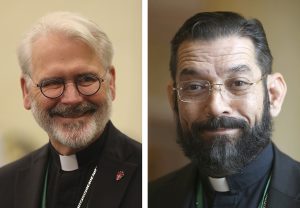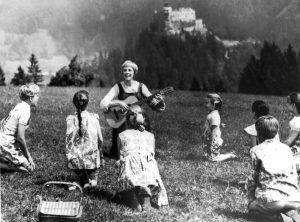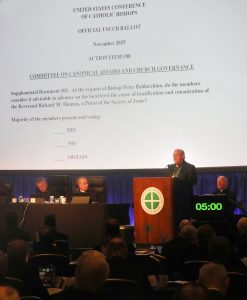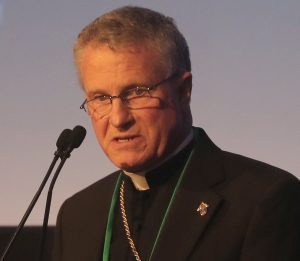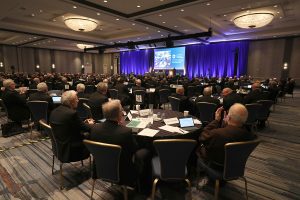BALTIMORE (OSV News) – The U.S. bishops have given the green light to hold the 11th National Eucharistic Congress in the summer of 2029, in a Nov. 12 vote on the final public day of the U.S. Conference of Catholic Bishops’ Fall Plenary Assembly.
The location of the event has not yet been made public. However, the possible cities have been narrowed down to three, according to Bishop Cozzens, and OSV News has learned that site visits have been completed and that the city announcement likely will come next spring.
The 2029 congress follows the successful 10th National Eucharistic Congress that took place July 2024 in Indianapolis, as part of the larger three-year National Eucharistic Revival.
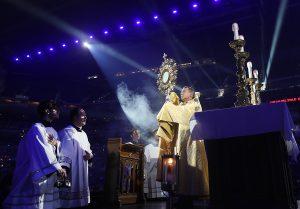
In a presentation to the body of bishops, Bishop Andrew H. Cozzens of Crookston, Minnesota, chairman of the National Eucharistic Congress Inc., which will organize the event, said the USCCB’s Committee on Evangelization Catechesis in conjunction with Vinea Research conducted a “Revival Impact Study” looking at the fruit of the earlier effort.
He said those findings will be released later this year.
“The results of this national survey are still being finalized,” but they found “lasting fruit from the revival,” Bishop Cozzens said. Areas of impact include increased reverence for the Eucharist, an increase in youth and family engagement, and a “noticeable increase” in Eucharistic adoration, he said.
The 2029 date works around the 2027 World Youth Day in South Korea and the 2028 International Eucharistic Congress in Sydney in 2028. Bishop Cozzens said it would also help the church “build on the momentum” ahead of the 500th anniversary of the apparition of Our Lady of Guadalupe to St. Juan Diego Cuauhtloatoatzin in Mexico in 2031.
“Brothers, I believe that the Eucharistic Revival was a great gift to our country from the Holy Spirit, and I believe that continuing the transformative, unitive events every four years can continue to stoke the fires of revival and support the incredible work that you’re already doing in your dioceses in evangelization,” Bishop Cozzens said.
No questions were asked from the floor.
Following the presentation and vote, Bishop Cozzens told OSV News that he was grateful to the bishops for their approval.
“Based on the feedback I was getting earlier, I thought that this is the way it would go. But it’s great to actually have it on the calendar so that we can go forward,” he said.
Bishop Cozzens said one of the gifts of the National Eucharistic Congress is the unity it brings the church — something he saw with the 2024 congress.
“I think we’ll experience that again in 2029,” he said. “I think it’s actually one of the gifts that the congress gives. It’s like the whole church gets together as one, and people get to see us united. And especially united around the source of our unity, which is Jesus and the Eucharist.
A theme is in progress, Bishop Cozzens said.
“I know that it will be a beautiful experience of the power of the Holy Spirit, and especially the power of evangelization when we honor Jesus and the Eucharist,” he said.
“I hope everybody comes,” Bishop Cozzens said.
Speaking of everybody, the U.S.-born Pope Leo XIV might be at the top of that invitation list. But Bishop Cozzens would not confirm whether or not the USCCB has formally issued an invitation.
“Let’s just put it this way: If the pope wants to come, we would welcome him,” Bishop Cozzens said.
The National Eucharistic Congress Inc., a nonprofit formed in 2022 to support the bishops’ vision for the congress and accompanying National Eucharistic Pilgrimage, has been a key collaborator for the revival as a whole.
Revival efforts included the development of catechetical resources and the training of both lay leaders and clergy to articulate the truth of the Eucharist and how that impacts Catholics’ lives.
April 2022 saw the commissioning of 58 Eucharistic preachers — priests formed during a retreat to give missions at parishes around the United States. It also included five National Eucharistic Pilgrimage routes, four in 2024 and an additional one in 2025.
The 2024 National Eucharistic Congress included nationally known Catholic speakers and musicians alongside opportunities for service, fellowship and varied forms of Catholic liturgies at the Indiana Convention Center and adjacent Lucas Oil Stadium. Each evening culminated in Eucharistic adoration in the stadium.
While more than 50,000 people are estimated to have attended the congress, thousands more joined for a Eucharistic procession through the streets of downtown Indianapolis — the largest of its kind in decades.
Jason Shanks, president of the National Eucharistic Congress, told OSV News the bishops’ overwhelming approval for a 2029 National Eucharistic Congress “really is a recognition of all the work the Lord has done over this revival.”
He noted there has been extensive discernment on the part of the bishops over the past year, between their conversations and examination of the impact study.
“I took it as a real positive affirmation of the fruits that we’re seeing and starting to see in the impact study,” he said.
Shanks said he’s going for “bigger and better” as they look toward 2029.
“I think there’s a lot of people that have said, ‘I wish I was there. I wish I was a part of it,'” he said. “We’re excited about it. We’re already planning for growth, not only growth in terms of numbers, but programming space and things.”
He said, “I can’t tell you the city yet, but I’m excited by where I think this is going.”



